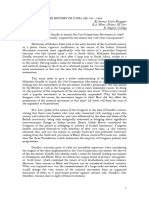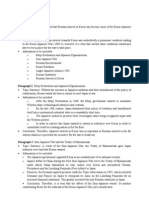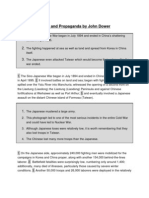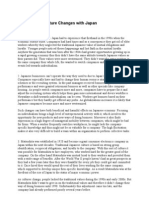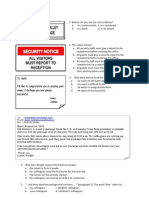Meiji Summary QS
Meiji Summary QS
Uploaded by
ryandalcampbellCopyright:
Available Formats
Meiji Summary QS
Meiji Summary QS
Uploaded by
ryandalcampbellOriginal Description:
Copyright
Available Formats
Share this document
Did you find this document useful?
Is this content inappropriate?
Copyright:
Available Formats
Meiji Summary QS
Meiji Summary QS
Uploaded by
ryandalcampbellCopyright:
Available Formats
The Meiji Restoration and Modernization
1. The Tokugawa lost power in Japan in 1868.
2.
The Emperor took over as the supreme head of state in Japan. emperors hadnt ruled Japan for hundreds of years.
3. This event was called the Restoration but in fact
1. In 1868 the Tokugawa shgun ("great general"), who ruled Japan in the feudal period, lost his power and 2. The emperor was restored to the supreme position. The emperor took the name Meiji ("enlightened rule") as his reign name; 3. this event was known as the Meiji Restoration.
1. At the start of the Meiji restoration, Japan was
militarily weak, undeveloped and was largely agricultural.
2. Most of Japan was controlled by feudal lords
(daimyos) who the government found it hard to control. 3. Japan had been forced to sign unequal treaties like in the case of China which controlled her foreign trade. 4. Another example similar to China, was that Western criminals committing crimes in Japan could not be tried in Japanese courts.
The Reign of the Meiji Emperor 1. When the Meiji emperor was restored as head of Japan in 1868, the nation was a militarily weak country, was primarily agricultural, and had little technological development. 2. It was controlled by hundreds of semiindependent feudal lords. 3. The Western powers Europe and the United States had forced Japan to sign treaties that limited its control over its own foreign trade and 4. required that crimes concerning foreigners in Japan be tried not in Japanese but in Western courts. 1. When the Meiji Emperor died in 1912 Japan had many of the features of a modern state including industry and a written constitution as well as powerful armed forces. 2. And Japan had also regained full control of foreign
trade and her legal system. 3. Japan had also fought and won two major wars (the Sino-Japanese War) and the Russo-Japanese War) 4. Many historians have wondered how Japan could have modernized so quickly?
1. When the Meiji period ended, with the death of the emperor in 1912, Japan had a highly centralized, bureaucratic government; a constitution establishing an elected parliament; a well-developed transport and communication system; a highly educated population free of feudal class restrictions; an established and rapidly growing industrial sector based on the latest technology; and a powerful army and navy. 2. Japan had regained complete control of its foreign trade and legal system, and, 3. by fighting and winning two wars (one of them against a major European power, Russia), it had established full independence and equality in international affairs. 4. In a little more than a generation, Japan had exceeded its goals, and in the process had changed its whole society. Japan's success in modernization has created great interest in why and how
it was able to adopt Western political, social, and economic institutions in so short a time. 1. One answer is in the nature of the Meiji constitution itself. 2. Because the Emperor ruled with the advice of a small number of ambitious samurai 3. This group moved quickly to make themselves stronger and weaken their enemies
1. One answer is found in the Meiji Restoration itself. This political revolution "restored" the emperor to power, but he did not rule directly. 2. He was expected to accept the advice of the group that had overthrown the shgun, and it was from this group that a small number of ambitious, able, and patriotic young men from the lower ranks of the samurai emerged to take control and establish the new political system. 3. At first, their only strength was that the emperor accepted their advice and several powerful feudal domains provided military support. They moved quickly, however, to build their own military and economic control. 1. The ruling group established control by asking feudal lords to give up their domains by 1869. 2. These domains were then abolished and merged into a unified Japan (as prefectures). 3. The old feudal lords and samurai were offered a yearly pension in return. This was later changed again to a one
off payment. 4. The samurai lost all class privileges as the new government declared all classes equal. 5. Then the wearing of swords were banned in 1876. 6. The former samurai cut their hair and took jobs in business and professions such as law. 1. By July 1869 the feudal lords had been requested to give up their domains, and 2. in 1871 these domains were abolished and transformed into prefectures of a unified central state. 3. The feudal lords and the samurai class were offered a yearly stipend, which was later changed to a one-time payment in government bonds. 4. The samurai lost their class privileges, when the government declared all classes to be equal. 5. By 1876 the government banned the wearing of the samurai's swords; 6. the former samurai cut off their top knots in favor of Western-style haircuts and took up jobs in business and the professions. 1. Further control was built through banning individual armies. 2. Then a national army was created. 3. And then a national tax system which generated more money for the government to spend on further development
1. The armies of each domain were disbanded, 2. and a national army based on universal conscription was created in 1872, requiring three years' military service from all men, samurai and commoner alike. 3. A national land tax system was established that required payment in money instead of rice, which allowed the government to stabilize the national budget. This gave the government money to spend to build up the strength of the nation. Samurai Resistance and Rebellion Defeated 1. Some samurai were unhappy with the changes. 2. These samurai wanted to invade Korea in 1872 while the leaders were away on a Western study trip. 3. This invasion would have made them important again. 4. The new leaders returned and stopped the planned invasion to focus on development. 5. The last samurai rebellion was defeated in 1877. It did not feature Tom Cruise although he is old enough to have been there.
1. Although these changes were made in the name of the emperor and national defense, the loss of privileges brought some resentment and rebellion. 2. When the top leadership left to travel in Europe and the United States to study Western ways in 1872, conservative groups argued that Japan should reply to Korean's refusal to revise a centuries old treaty with an invasion. 3. This
would help patriotic samurai to regain their importance. 4. But the new leaders quickly returned from Europe and reestablished their control, arguing that Japan should concentrate on its own modernization and not engage in such foreign adventures. For the next twenty years, in the 1870s and 1880s, the top priority remained domestic reform aimed at changing Japan's social and economic institutions along the lines of the model provided by the powerful Western nations. 5. The final blow to conservative samurai came in the 1877 Satsuma rebellion, when the government's newly drafted army, trained in European infantry techniques and armed with modern Western guns, defeated the last resistance of the traditional samurai warriors. With the exception of these few samurai outbreaks, Japan's domestic transformation proceeded with remarkable speed, energy, and the cooperation of the people. This phenomenon is one of the major characteristics of Japan's modern history. Ideology 1. Modern Japanese identity was created around the emperor 2. The emperor was a symbol of Japanese tradition 3. He was also head of the Shinto religion 4. These two things combined made him a symbol of national unity and built support for modernization.
1. In an effort to unite the Japanese nation in response to
the Western challenge, the Meiji leaders created a civic ideology centered around the emperor. 2. Although the emperor wielded no political power, he had long been viewed as a symbol of Japanese culture and historical continuity. 3. He was the head of the Shint religion, Japan's native religion. Among other beliefs, Shint holds that the emperor is descended from the sun goddess and the gods who created Japan and therefore is semidivine. Westerners of that time knew him primarily as a ceremonial figure. The Meiji reformers brought the emperor and Shint to national prominence, replacing Buddhism as the national religion, for political and ideological reasons. By associating Shint with the imperial line, which reached back into legendary times, Japan had not only the oldest ruling house in the world, but a powerful symbol of age-old national unity. 4. The people seldom saw the emperor, yet they were to carry out his orders without question, in honor to him and to the unity of the Japanese people, which he represented. In fact, the emperor did not rule. It was his "advisers," the small group of men who exercised political control that devised and carried out the reform program in the name of the emperor. Social and Economic Changes 1. Getting rid of the old class system led to many changes. 2. People were free to choose jobs and travel around Japan. 3. The reforms also led to investment in new industry
and technology. 4. The government led the way by building railways and other infrastructure projects. 5. These proved expensive so the government sold them to private investors which in turn led to more growth.
1. The abolition of feudalism made possible tremendous social and political changes. 2. Millions of people were suddenly free to choose their occupation and move about without restrictions. 3. By providing a new environment of political and financial security, the government made possible investment in new industries and technologies. 4. The government led the way in this, building railway and shipping lines, telegraph and telephone systems, three shipyards, ten mines, five munitions works, and fifty-three consumer industries (making sugar, glass, textiles, cement, chemicals, and other important products). 5. This was very expensive, however, and strained government finances, so in 1880 the government decided to sell most of these industries to private investors, thereafter encouraging such activity through subsidies and other incentives. Some of the samurai and merchants who built these industries established major corporate conglomerates called zaibatsu, which controlled much of Japan's modern industrial sector. Government and Education
1. The government also built a national education system, parliament (Diet) and a constitution. 2. By 1912 the national education system created in 1872 led to almost every Japanese attending at least 6 years of free public school. 3. These schools also stressed the importance of the emperor and unity. 4. A constitution was created in 1889 which kept power initially with the new ruling elite. 5. Japan even modeled its new criminal code on European countries. 6. All these changes worked and, in massive contrast to China, the Japanese unequal treaties were revised in 1894.
1. The government also introduced a national educational system and a constitution, creating an elected parliament called the Diet. They did this to provide a good environment for national growth, win the respect of the Westerners, and build support for the modern state. In the Tokugawa period, popular education had spread rapidly, and 2. in 1872 the government established a national system to educate the entire population. By the end of the Meiji period, almost everyone attended the free public schools for at least six years. 3. The government closely controlled the schools, making sure that in addition to skills like mathematics and reading, all students studied "moral training," which stressed the
importance of their duty to the emperor, the country and their families. 4. The 1889 constitution was "given" to the people by the emperor, and only he (or his advisers) could change it. A parliament was elected beginning in 1890, but only the wealthiest one percent of the population could vote in elections. In 1925 this was changed to allow all men (but not yet women) to vote. To win the recognition of the Western powers and convince them to change the unequal treaties the Japanese had been forced to sign in the 1850s, 5. Japan changed its entire legal system, adopting a new criminal and civil code modeled after those of France and Germany. 6. The Western nations finally agreed to revise the treaties in 1894, acknowledging Japan as an equal in principle, although not in international power. The Sino-Japanese War 1. Japan fought Qing China in 1894 over Korea. 2. One of the reasons for the conflict was that the Japanese did not want the Russians in the Korean peninsula. 3. Japan won the war and gained Taiwan as a colony. 4. Japans victory surprised many people.
1. In 1894 Japan fought a war against China over its interest in Korea, which China claimed as a vassal state. 2. The Korean peninsula is the closest part of Asia to
Japan, less than 100 miles by sea, and the Japanese were worried that the Russians might gain control of that weak nation. 3. Japan won the war and gained control over Korea and gained Taiwan as a colony. 4. Japan's sudden, decisive victory over China surprised the world and worried some European powers.
The International Climate: Colonialism and Expansion 1. This happened at the same time as the scramble for concessions in China was beginning. 2. Japan tried to join in by securing special rights over Chinas Liaotung peninsula as well as Taiwan. 3. The European powers ganged up on Japan to force her to give up Liaotung. 4. The European powers then took more of China for themselves. The scramble for concessions was in full swing. 5. Russia took the Liaotong peninsula
1. At this time the European nations were beginning to claim special rights in China the French, with their colony in Indochina (today's Vietnam, Laos, and Cambodia), were involved in South China; the British also claimed special rights in South China, near Hong Kong, and later the whole Yangtze valley; and the Russians, who were building a railway through Siberia and Manchuria, were interested in North China. 2. After Japan's victory over China, Japan signed a treaty with China which gave Japan special rights on China's Liaotung peninsula, in addition to the control of Taiwan. 3. But Japan's victory was short lived. Within a week, France, Russia, and Germany combined to pressure Japan to give up rights on the Liaotung peninsula. 4. Each of these nations then began to force China to give it ports, naval bases, and special economic rights, 5. with Russia taking the same Liaotung peninsula that Japan had been forced to return.
The Russo-Japanese War 1. This made the Japanese angry. 2. The Russians began to threaten Korea in 1904. 3. Japan declared war on Russia and won in 1905. 4. Japan had not only secured Korea but had now made the others realize she was a colonial power.
1. The Japanese government was angered by this incident and drew the lesson that for Japan to maintain its
independence and receive equal treatment in international affairs, it was necessary to strengthen its military even further. 2. By 1904, when the Russians were again threatening to establish control over Korea, Japan was much stronger. 3. It declared war on Russia and, using all its strength, won victory in 1905 (beginning with a surprise naval attack on Port Arthur, which gained for Japan the control of the China Sea). 4. Japan thus achieved dominance over Korea and established itself a colonial power in East Asia.
You might also like
- TMA01 Handout Planner For Final Work 1Document11 pagesTMA01 Handout Planner For Final Work 1Eland ExamsNo ratings yet
- Goto - Japan's National Innovation System, Current Status and ProblemsDocument11 pagesGoto - Japan's National Innovation System, Current Status and ProblemsMario HutabaratNo ratings yet
- Understanding Japanese Management PracticesDocument16 pagesUnderstanding Japanese Management PracticesBusiness Expert Press100% (3)
- MeijiDocument18 pagesMeijiapi-283804229No ratings yet
- Meiji Restoration Bibliography Primary SourcesDocument4 pagesMeiji Restoration Bibliography Primary Sourcesapi-2725826490% (1)
- Revision Notes - Changes in JapanDocument61 pagesRevision Notes - Changes in JapanPluto ButtholeNo ratings yet
- Military Modernization of JapanDocument10 pagesMilitary Modernization of JapanRamita UdayashankarNo ratings yet
- Modeern JappanDocument10 pagesModeern JappanRimpa KarmakarNo ratings yet
- Brief History of JapanDocument2 pagesBrief History of Japandict_domingoNo ratings yet
- The Meiji RestorationDocument40 pagesThe Meiji Restorationapi-309710992100% (1)
- MeijiDocument24 pagesMeijihakuna matataNo ratings yet
- The Meiji Restoration - Roots of Modern JapanDocument18 pagesThe Meiji Restoration - Roots of Modern Japanapi-308028465No ratings yet
- The Modern Japan AssignmentDocument23 pagesThe Modern Japan Assignment19KANISHKNo ratings yet
- Unit-9 Japan Transition To ModernizationDocument12 pagesUnit-9 Japan Transition To ModernizationAadil ManZoorNo ratings yet
- Japanese IndustrializationDocument4 pagesJapanese IndustrializationTruckerNo ratings yet
- Japanese ImperialismDocument10 pagesJapanese ImperialismDevin ValladeNo ratings yet
- ZaibatsuDocument5 pagesZaibatsuAnusua ChowdhuryNo ratings yet
- Final Paper: ASIA 519 History of Japanese International Relations and Foreign PolicyDocument9 pagesFinal Paper: ASIA 519 History of Japanese International Relations and Foreign PolicysmrithiNo ratings yet
- Revolt of 1857 - ConsequencesDocument1 pageRevolt of 1857 - ConsequencesRamita UdayashankarNo ratings yet
- Japans Post War Economic MiracleDocument12 pagesJapans Post War Economic Miraclekorum8urraNo ratings yet
- Key Topic 1: The Collapse of The Tsarist Regime 1917: REVISION NOTES - Russia 1905-1941Document14 pagesKey Topic 1: The Collapse of The Tsarist Regime 1917: REVISION NOTES - Russia 1905-1941harry3196No ratings yet
- Industrialization JAPANDocument9 pagesIndustrialization JAPANAkriti KhannaNo ratings yet
- Japan Political HistoryDocument2 pagesJapan Political HistoryJoshua Mhel Samaniego100% (1)
- 01 The Age of ReasonDocument5 pages01 The Age of ReasonAngela KrstevskaNo ratings yet
- Emergence of Regional Powers CLASSDocument11 pagesEmergence of Regional Powers CLASSUjjwal DagarNo ratings yet
- Manchurian Crisis NotesDocument4 pagesManchurian Crisis NotesAryaa KapilNo ratings yet
- Meiji RestorationDocument11 pagesMeiji RestorationNeelamNo ratings yet
- Sino-Japanese War QSDocument8 pagesSino-Japanese War QSryandalcampbell100% (1)
- The Spanish-American War (History 70)Document11 pagesThe Spanish-American War (History 70)Tine AtaamNo ratings yet
- Meiji Constitution PDFDocument5 pagesMeiji Constitution PDFsmrithiNo ratings yet
- Essay - 1905 RevolutionDocument5 pagesEssay - 1905 RevolutionDaniel StephanNo ratings yet
- Meiji ReformsDocument4 pagesMeiji Reformsfarheen ashrafNo ratings yet
- Causes of The Cold WarDocument9 pagesCauses of The Cold WarSPD TIWARI100% (1)
- World War 1Document5 pagesWorld War 1Pradeep RajaNo ratings yet
- Effects of The Meiji RestorationDocument8 pagesEffects of The Meiji RestorationChris Powers100% (1)
- A. Bhattacharya - The Boxer Rebellion I-1Document20 pagesA. Bhattacharya - The Boxer Rebellion I-1Rupali 40No ratings yet
- (Chapter8) The First World War (1914-1918)Document30 pages(Chapter8) The First World War (1914-1918)Joshua ChanNo ratings yet
- KANNAKIDocument1 pageKANNAKIDiveka Sri PerumalsamyNo ratings yet
- Economic Reforms - MeijiDocument7 pagesEconomic Reforms - Meijisourabh singhalNo ratings yet
- The Chinese Civil War Notes and EssayDocument11 pagesThe Chinese Civil War Notes and Essaybabban05100% (1)
- Crisis of Tokugawa Regime in JapanDocument13 pagesCrisis of Tokugawa Regime in JapanNeelamNo ratings yet
- March First MovementDocument4 pagesMarch First MovementM.K.100% (1)
- US OCCUPation and How It Influenced JDocument18 pagesUS OCCUPation and How It Influenced JsmrithiNo ratings yet
- Unification of Italy ReadingDocument4 pagesUnification of Italy ReadingDávid OroszNo ratings yet
- May 4th MovementDocument8 pagesMay 4th MovementShreyashi KashyapNo ratings yet
- And Mao Makes 5: Mao Tsetung's Last Great Battle by Raymond Lotta, (Chicago: Banner Press, September 1978)Document539 pagesAnd Mao Makes 5: Mao Tsetung's Last Great Battle by Raymond Lotta, (Chicago: Banner Press, September 1978)Kalovski Itim100% (1)
- PATRIARCHYDocument49 pagesPATRIARCHYVeronica VillaNo ratings yet
- PM Sangrahlaya ReportDocument12 pagesPM Sangrahlaya ReportDiwakar kumarNo ratings yet
- Satsuma RebellionDocument12 pagesSatsuma RebellionRuh Javier AlontoNo ratings yet
- Progressive Historiography of The American War For IndependenceDocument11 pagesProgressive Historiography of The American War For IndependenceNessma baraNo ratings yet
- History Project Reforms of Lord William Bentinck: Submitted By: Under The Guidelines ofDocument22 pagesHistory Project Reforms of Lord William Bentinck: Submitted By: Under The Guidelines ofshavyNo ratings yet
- Nature of The Taiping MovementDocument7 pagesNature of The Taiping MovementHarshita SaxenaNo ratings yet
- Sepoy Munity 1857Document43 pagesSepoy Munity 1857KrishnaNo ratings yet
- Unification of Italy 1Document5 pagesUnification of Italy 1Jitendra KushwahaNo ratings yet
- Perestroika & GlasnostDocument3 pagesPerestroika & GlasnostAiman Saif Ullah 729-FSS/BSIR/F19100% (1)
- Colonisation of IndiaDocument18 pagesColonisation of IndiaShabina ParveenNo ratings yet
- Gandhi and The Non-Cooperation MovementDocument6 pagesGandhi and The Non-Cooperation MovementAliya KhanNo ratings yet
- CH 10 Sec 1 - The Rise of Islam PDFDocument6 pagesCH 10 Sec 1 - The Rise of Islam PDFJ. NievesNo ratings yet
- History of The Republic of ChinaDocument24 pagesHistory of The Republic of Chinaaquel1983No ratings yet
- History Development of JapanDocument19 pagesHistory Development of JapanRazia IslamNo ratings yet
- Meiji RestorationDocument5 pagesMeiji Restorationranveer.rathod099No ratings yet
- WHP-1750 3-2-5 Read - Meiji Restoration - 940LDocument8 pagesWHP-1750 3-2-5 Read - Meiji Restoration - 940LPoco ChanNo ratings yet
- Modern Japan East Asian StudiesDocument12 pagesModern Japan East Asian Studies19KANISHKNo ratings yet
- Guomindang GMD NotesDocument2 pagesGuomindang GMD NotesryandalcampbellNo ratings yet
- IB HL History Exam Essay-Planning GuideDocument1 pageIB HL History Exam Essay-Planning GuideryandalcampbellNo ratings yet
- 12HLRepublic of China and The RiseDocument2 pages12HLRepublic of China and The RiseryandalcampbellNo ratings yet
- Gorbachev and The Decline of Soviet Power QSDocument7 pagesGorbachev and The Decline of Soviet Power QSryandalcampbellNo ratings yet
- Plan - Causes of Russo-Japanese WarDocument3 pagesPlan - Causes of Russo-Japanese WarryandalcampbellNo ratings yet
- Sino-Japanese War QSDocument8 pagesSino-Japanese War QSryandalcampbell100% (1)
- Sino-Japanese War QSDocument8 pagesSino-Japanese War QSryandalcampbell100% (1)
- Prints and Propaganda QSDocument3 pagesPrints and Propaganda QSryandalcampbellNo ratings yet
- Lesson 6 Fola-001 Ppt.Document7 pagesLesson 6 Fola-001 Ppt.Cyrell AsidNo ratings yet
- Abe Advocates Security Diamond Against China - Asia - DW - de - 21.01Document3 pagesAbe Advocates Security Diamond Against China - Asia - DW - de - 21.01vishalbattulaNo ratings yet
- Japanese Emigration To Latin AmericaDocument45 pagesJapanese Emigration To Latin AmericaRene EudesNo ratings yet
- Architectural Membranes: Case StudiesDocument48 pagesArchitectural Membranes: Case Studiescvengr229No ratings yet
- Thayer Australia-Japan Reciprocal Access AgreementDocument4 pagesThayer Australia-Japan Reciprocal Access AgreementCarlyle Alan ThayerNo ratings yet
- Statement of PurposeDocument2 pagesStatement of Purposeapi-438667529No ratings yet
- Yabuarticletranslation1932 FinalDocument6 pagesYabuarticletranslation1932 FinalKentsu YabuNo ratings yet
- (2006 - Tamura) Wind Resistand Design of Tall Buildings in JapanDocument20 pages(2006 - Tamura) Wind Resistand Design of Tall Buildings in JapanDuchatteNo ratings yet
- "Karoshi": The Death by Overworking Problems of Japanese WorkersDocument12 pages"Karoshi": The Death by Overworking Problems of Japanese WorkersfranzNo ratings yet
- Matsushita's Culture Changes With JapanDocument2 pagesMatsushita's Culture Changes With JapanTooShort4BBall100% (2)
- IBM Global AI Adoption Index Report Dec. 2023Document71 pagesIBM Global AI Adoption Index Report Dec. 2023zoulinfNo ratings yet
- DLL - MAPEH - 8 - 2nd QUARTER - WEEK 5 ARTSDocument6 pagesDLL - MAPEH - 8 - 2nd QUARTER - WEEK 5 ARTSJosh P100% (1)
- Sr. AccountantDocument3 pagesSr. Accountantapi-78187618No ratings yet
- Jica Scholarships JICA: Information On Master's Degree and Internship Program of The African Business Education (ABE) Initiative For YouthDocument9 pagesJica Scholarships JICA: Information On Master's Degree and Internship Program of The African Business Education (ABE) Initiative For Youthjayonetz100% (1)
- How Globalized Is Your Home: Made in TotalDocument2 pagesHow Globalized Is Your Home: Made in TotalDexter Guinto NaborNo ratings yet
- Our Ideal Holiday: Orșan Cristina & Boari Violeta Prof - Domide Alina Liceul Teoretic SanitarDocument5 pagesOur Ideal Holiday: Orșan Cristina & Boari Violeta Prof - Domide Alina Liceul Teoretic SanitarAna CulceanNo ratings yet
- GDP - GNPDocument30 pagesGDP - GNPHANISHA MODYNo ratings yet
- ITB World Travel Trends Report 2010/2011Document30 pagesITB World Travel Trends Report 2010/2011Pablo AlarcónNo ratings yet
- USSBS List of Reports, Pacific WarDocument8 pagesUSSBS List of Reports, Pacific WarJapanAirRaids100% (1)
- Nicolas Fieve - Paul Waley - Japanese Capitals in Historical Perspective - Place, Power and Memory in Kyoto, Edo and Tokyo-Routledge (2013)Document433 pagesNicolas Fieve - Paul Waley - Japanese Capitals in Historical Perspective - Place, Power and Memory in Kyoto, Edo and Tokyo-Routledge (2013)brankaNo ratings yet
- SEAA Conference ProgramDocument16 pagesSEAA Conference ProgramBo AnNo ratings yet
- FL ModuleDocument38 pagesFL ModuleChichay Pesieto100% (1)
- Neuman EASTASIANSOCIETIESDocument121 pagesNeuman EASTASIANSOCIETIESAlexie Anne MariñoNo ratings yet
- Food Culture in JapanDocument230 pagesFood Culture in JapanIstván Fehér100% (4)
- Spring On The Korean PeninsulaDocument4 pagesSpring On The Korean PeninsulaRobert MariasiNo ratings yet
- Japanese CultureDocument35 pagesJapanese CultureKris Tine100% (1)
- Soal SKL 2Document8 pagesSoal SKL 2Budiyono SlametNo ratings yet
























































